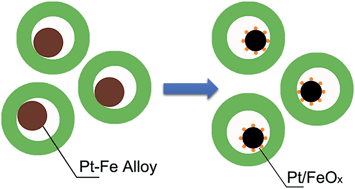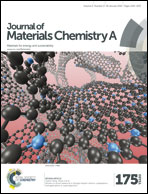Ultrafine platinum/iron oxide nanoconjugates confined in silica nanoshells for highly durable catalytic oxidation†
Abstract
Noble metal/transition metal (hydr)oxide interfaces are often highly active catalytic sites for many oxidation reactions. One of the challenges in such catalyst systems especially in high-temperature reactions is the lack of an effective mechanism to stabilize the catalysts against sintering over time and to maintain the metal/oxide interfaces. Herein, we report an alloying–dealloying process for the production of ultrafine Pt/FeOx nanoconjugates (∼1.8 nm) with confinement in silica nanoshells for effective stabilization. The synthesis started with coating of ultrasmall Pt/Fe precursor nanoparticles in reverse micelles by a microporous silica shell, which served as a nanoreactor to allow the subsequent transformation of the precursor nanoparticles into the target Pt/FeOx nanoconjugates. Thanks to the ultrasmall size of the nanoconjugates and their effective protection by the silica shells, the resulting Pt/FeOx@SiO2 yolk/shell nanospheres showed high catalytic activity and remarkable durability in preferential CO oxidation in H2 (PROX). This synthesis strategy may represent a general approach in rational design of highly stable catalysts with complex nanostructures for a broad range of catalysis.


 Please wait while we load your content...
Please wait while we load your content...